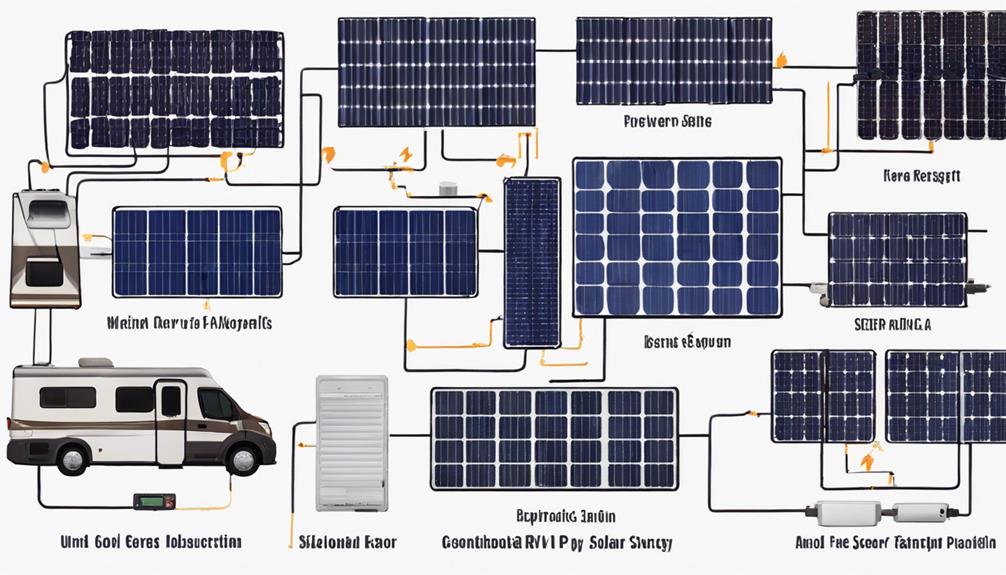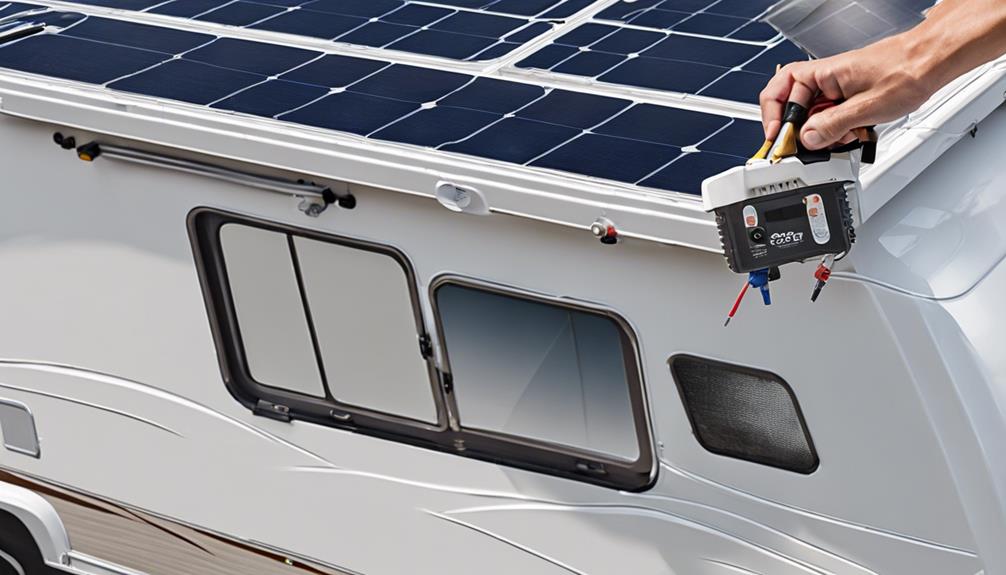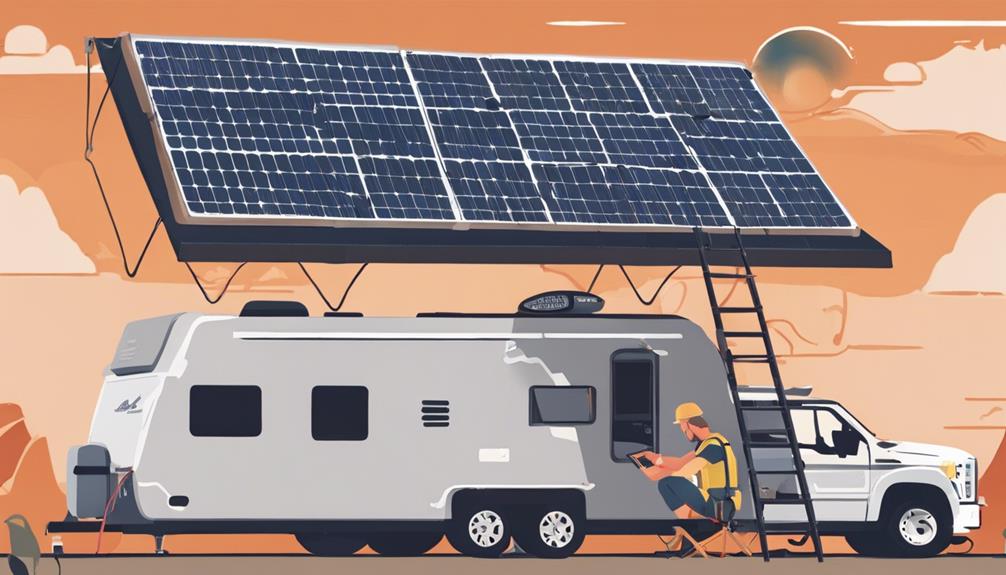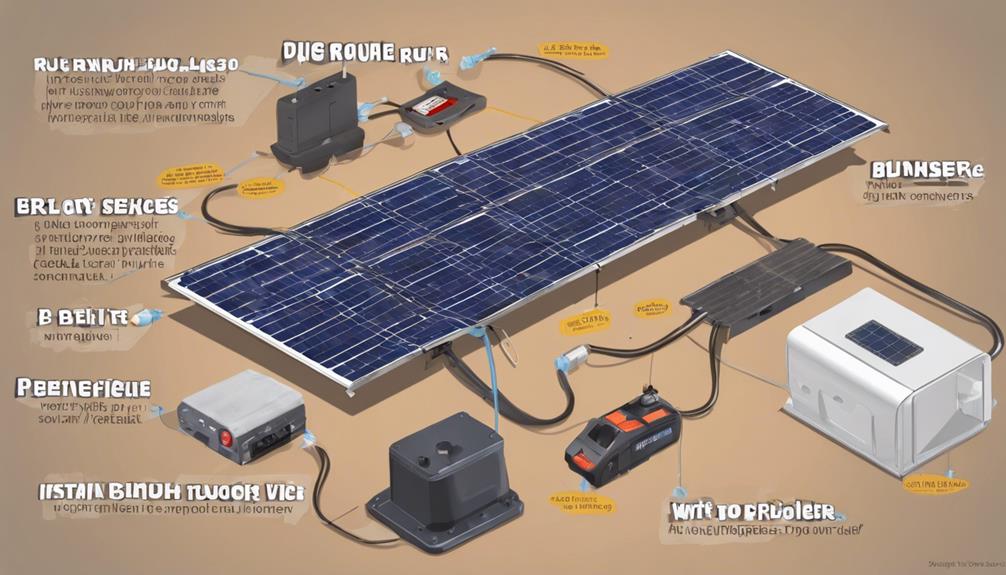To install solar panels on your RV, start by selecting the right system based on energy needs, space, and budget. Check roof space and structure, assess weight support, and verify electrical capacity. Mount panels securely using appropriate hardware and accessories. Connect panels properly using cables and connectors, optimizing placement for sunlight exposure. Test the setup regularly for efficiency and troubleshoot any issues. This detailed process guarantees a successful installation.
Selecting the Right Solar Panel System

When choosing a solar panel system for your RV, consider factors like energy requirements, available space, and budget constraints. Solar panel efficiency plays an essential role in maximizing energy production. Look for panels with high efficiency ratings to make the most of the available sunlight.
Budget considerations are also important; balance the upfront cost of the system with long-term savings on energy bills.
If you're looking for flexibility and mobility, portable solar options are worth exploring. These systems can be moved and adjusted to capture the most sunlight throughout the day.
Additionally, consider the off-grid capabilities of the solar panel system. If you plan on boondocking or camping in remote locations, having a system that can operate independently from traditional power sources is vital for a continuous power supply.
Preparing Your RV for Installation
To prepare your RV for solar panel installation, assess the roof space and structural integrity for mounting the panels securely. Begin by conducting an RV roof evaluation to confirm it can support the weight of the solar panels. Check for any signs of damage or weak spots that may need reinforcement before proceeding with installation.
Next, perform an electrical system check to verify it can accommodate the solar panels and handle the additional power load they'll generate.
When determining solar panel placement, consider factors such as maximizing sunlight exposure and avoiding obstructions like vents or air conditioning units. Plan the layout carefully to make the most efficient use of available space on the roof.
Additionally, implement weatherproofing techniques to protect both the panels and your RV from moisture damage. Proper sealing and securing of the panels will help prevent leaks and guarantee longevity.
Mounting Solar Panels on Your RV

Begin the process of mounting solar panels on your RV by selecting the appropriate mounting hardware suited for your roof type and ensuring it's securely attached for best performance and safety.
When choosing the mounting hardware, consider the type of solar panels you have. There are various solar panel types, such as rigid panels, flexible panels, or portable panels, each requiring specific installation accessories.
For rigid panels, you'll typically use mounting brackets that are attached to the roof with bolts or screws. These brackets provide a secure base for the panels.
Flexible panels may require adhesive mounts that are compatible with your RV's roof material. Portable panels often come with adjustable stands or clamps that can be easily set up wherever needed.
Ensure that the installation accessories you use are of high quality and designed for the specific solar panel type you have. Proper installation won't only maximize the efficiency of your solar panels but also prevent any damage to your RV during travel.
Connecting and Wiring the Solar Panels
Make certain that you have the necessary cables and connectors to properly connect and wire the solar panels on your RV for effective power generation.
When connecting your solar panels, make sure that the panel orientation is optimized for maximum sunlight exposure. Ideally, the panels should face south to receive the most sunlight throughout the day.
For proper cable management, carefully route the cables from the solar panels to the charge controller and then to the RV's battery bank. Use cable clips or zip ties to secure the cables along the roof and sides of the RV, ensuring they're out of the way and protected from potential damage.
When connecting the solar panels to the charge controller, follow the manufacturer's instructions to guarantee a safe and efficient connection. Double-check all connections to make certain they're secure and properly insulated to prevent any electrical hazards.
Properly wiring your solar panels is essential for a successful installation and best power generation for your RV.
Testing and Optimizing Your Solar Setup

Assure the proper functioning of your solar setup by conducting thorough testing and optimization procedures. To maximize efficiency, monitor the solar panels' output regularly using a multimeter to verify they're generating the expected power.
Check the charge controller's readings to confirm that it's regulating the energy flow correctly and charging the batteries efficiently. Additionally, assess your battery storage capacity to confirm it meets your energy needs and consider expanding it if necessary.
For troubleshooting, keep an eye out for any loose connections, damaged cables, or shading that may be impacting your system's performance. Regularly clean the solar panels to prevent dirt buildup that could decrease their efficiency.
Perform maintenance checks on the batteries, ensuring they're in good condition and properly connected to the system. Implement these maintenance tips to prolong the lifespan of your solar setup and keep it running smoothly during your RV adventures.
Frequently Asked Questions
Do Solar Panels Work in Cloudy Weather?
In cloudy weather, solar panels still work but at reduced efficiency. Consider optimizing your RV's energy storage solutions to maximize power usage. Monitor output and adapt to guarantee continuous energy supply despite varying weather conditions.
How Do I Maintain Solar Panels on an Rv?
To maintain solar panels on your RV, follow these cleaning tips: Use a mild soap and water solution, avoid abrasive materials, and clean regularly. For troubleshooting techniques, monitor performance, check connections, and consult a professional if needed.
Can I Use Solar Panels While Driving?
While driving, solar panels on your RV can generate electricity, enhancing energy efficiency. Proper installation is essential to guarantee panels are secure and functional. Utilize the power generated to charge batteries and run appliances.
What Should I Do in Case of Hail Damage?
If hail damages your RV solar panels, make sure to check your insurance coverage for repairs. To prevent future damage, consider adding protective measures like hail guards. These precautions can save you from costly repairs down the road.
Are There Any Regulations for Solar Panels on Rvs?
To guarantee compliance with permit requirements and safety regulations when installing solar panels on RVs, research local codes. Consult with authorities to understand specific guidelines. Adhering to regulations will help you avoid potential fines and assure safe installation.
Conclusion
Now that your solar panels are installed on your RV, you can enjoy the benefits of clean, renewable energy while on the road.
Remember to regularly monitor and maintain your solar setup to achieve peak performance.
With proper care and attention, your solar panels will continue to provide you with electricity for years to come.
Safe travels and happy solar camping!
